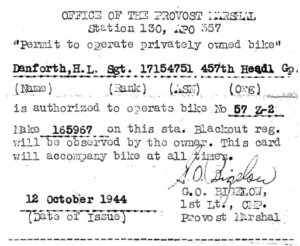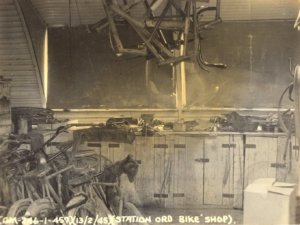Bicycles were the best way to get around base and more important made it easier to make your way to one of the local pubs. There were many bikes at the base because about 400 hundred bikes were ordered and delivered on February 10th 1944 at base as ‘essential equipment’. When one crew finished their tour of duty the bikes were assigned to someone who ‘needed’ one. The privately owned bikes would sometimes be sold to the newcomers or to crews who just hadn’t been lucky enough to get their hands on one. Some guys bought their first bike in England.
Here’s what Clifford B. Digre writes in his book ‘Into Life’s School:
“Sid and I bought bicycles from a crew in the hut next to our who no longer needed them; they had completed their tour and were going home. I paid nearly four pounds (16 dollars), about the price of a good bottle of Scotch, for an old beat up but usable bike. Some years ago I had sold my classmate John Midtaune a bike in very good condition for three dollars. Bikes were at a premium here. Our bikes would make our trips to Sawtry easier, so I was sure we could be there more often”.
Not sure is applied to all bikes but in our archives is a ‘bike card’ that was issued by the Office of the Provost Marshal. It says that the cardholder is allowed to operate a privatly owned bike. I hope that veterans or families can tell us a bit more about these bike cards. The card also states that the owner of the bike must always observe the black out rules.
The MP’s were very stricked about the rules as Clifford B. Digre and his friend Sid found out:
“Sid and I had to sign the 104th Article of War acknowledging our violation for riding our bikes without lights. As Sid and I were coming back from The Oddfellows Arms pub in Sawtry, the MP’s pulled us over on the road, asked for our ID’s, and gave us a citation for not having lights on our bikes. They confiscated our two bikes, put them in their jeep, and we had to walk back to base. Later, we appeared at the MP office to reclaim our bikes. The penalty never materialized. What a joke.”
The local bike shop, located in Holme, did good business with the Americans too. Here is what Bill Ayres, his family owned the bike shop in Holme, has to say about it: “We had plenty of business from the Americans, many of them wanted bikes to get to the pubs.”
The airbase even had it’s own bike shop to repair bikes and had a bunch of extra bike frames hanging around the shop.
Bikes weren’t always being sold or bought. Sometimes the owners wouldn’t return from a mission and others would start using the bikes.
On September 26th 1944 Donald Reilly and his crew were shot down while returning from the Osnabrück mission. Donald Reilly had bought a red bike and loved cycling around the base. He wrote his mother and sister about the bike he bought and the fun he had with it. Donald died that September 26th when he parachuted in a lake and drowned. His mother was heartbroken when she found out that Donald had died at the age of 19.
After the war his mother wrote a letter to the Army Effects Bureau: “He also had personal letters, toilet articles, pictures and a bicycle. I didn’t expect the bicycle to be returned to us but I would like to know what became of it”. What did happen to all the bikes at Glatton? Did they return to the US or were they sold in the UK?
Bikes that were abandoned would eventually be stored at the MP’s guardhouse as we can read in the daily report of November 8th 1944. Men were given the chance to reclaim their bicycles before November 13th 1944. After November 13th 1944 Goverment Issue bicycles would be turned in to the Station Ordnance and civilian bicycles would be disposed of through public auction, which would eventually be November 24th 1944.
Having a bike meant a lot…it was the difference between walking to your next location or riding to it…






